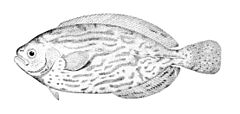en
names in breadcrumbs


Medusafishes are a family, Centrolophidae, of percomorph fishes. The family includes about 31 species. They are found in temperate and tropical waters throughout the world.
Young Icichthys lockingtoni specimens are abundant in the coastal waters of the north Pacific, where they are often found in association with jellyfish, which provide them with protection from predators and opportunities to scavenge the remains of the jellyfishes' meals.
The following genera are classified within the family Centrolophidae:[2]



Medusafishes are a family, Centrolophidae, of percomorph fishes. The family includes about 31 species. They are found in temperate and tropical waters throughout the world.
Young Icichthys lockingtoni specimens are abundant in the coastal waters of the north Pacific, where they are often found in association with jellyfish, which provide them with protection from predators and opportunities to scavenge the remains of the jellyfishes' meals.